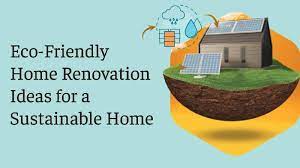In this article, we discussed the eco friendly home improvement to save energy. We also talked about the meaning of eco-friendly home.
Definition
Eco-friendly home improvements order renewable and recyclable resources, harness natural energy sources like solar power, and aim to improve indoor environmental quality.
An eco friendly house is a type of house that utilizes significantly fewer resources than a traditional one.
Eco-friendly houses consume energy and water more efficiently than their conventional counterparts.
To make this happen, factors like building orientation, geometry/shape, building envelope, window to-wall ratio, shading & daylighting need to be planned in great detail.
Consequently, planning and design are the most important stages in building an eco-friendly home.
Energy saving means using energy more efficiently and effectively. This helps to conserve resources and reduce environmental impacts, while at the same time generating financial savings. Energy conservation is also critical for the security and sustainability of the energy supply because energy resources are limited and energy consumption is constantly increasing. Therefore, Energy conservation is an important concept that promotes more efficient use of energy resources at both individual and societal levels.
Eco-Friendly Home Improvements to Save Energy
Many maintainable home improvement switches can be done in a matter of minutes—like switching out your lightbulbs. Other projects call for more skill and an upfront expense, but the benefits that come from ec Switch to LED Light Bulbs
When you’re ready to dip your toes into the waters of sustainable home improvements, switching to energy-efficient lighting is a simple, inexpensive way to start: Next time a lightbulb goes out, just replace it with an LED bulb. Truly, using this choice is a no-brainer.
Although LED bulbs are slightly more expensive to purchase than traditional glowing bulbs, they pay off in terms of longevity and energy savings. You can use LED bulbs throughout the house as well as for holiday lights or landscape lights. o-friendly home improvements are priceless.
Upgrade Your Windows
Heating and cooling your home use a lot of energy throughout the year—and old windows can be a significant contributor to your energy demands. According to the U.S. Department of Energy, about 25% of home energy is wasted through windows. The good news is that an effective way to cut down on that waste is by upgrading to dual-paned windows that are properly sealed. Although new windows can be costly, there is a good return on investment, and rebates or credits are often available.
Install a Tankless Water Heater
With traditional tank water heaters, water is continuously held and heated in the tank until it is needed. However, if you don’t need that much water, then you’re wasting a significant amount of energy each year just to keep an excess amount of water heated. As an eco-friendly alternative, tankless water heaters work by heating water on-demand as it passes through pipes—which comes with the added benefit of never running out of hot water. (No more cold showers!)
Although tankless water heaters are more expensive to purchase and install than tank water heaters, the energy savings and better lifespan can ultimately help offset the cost.
Update Your Plumbing
Since 1994, federal standards have required that plumbing fixtures use less water. That means if your toilet, bathtub, shower or other plumbing fixtures pre-date the early 1990s, you are likely wasting a lot of water (and money) each year. For example, by switching to a Water Sense labeled toilet model, you can reduce toilet water use by 20% to 60% annually. That translates to about $140 in savings each year, which can easily help pay for the new toilet within a few years.
Prioritize Energy-Efficient Appliances
There have been significant advances in the past decades when it comes to energy-efficient appliances—think less heat lost through the oven and colder retained in the freezer. If you are in the market for new appliances, prioritize ones that are Energy Star certified. This means the appliance meets U.S. Department of Energy’s strict criteria for energy efficiency.
Upgrade to an Eco-Friendly Fireplace
In many homes, the fireplace is a nice important point that adds some environment during colder weather. But, that’s a missed opportunity: With an energy-efficient fireplace that helps heat your home with a renewable energy source, you can reduce your heating costs while helping the environment.
The most efficient, eco-friendly fireplace option is a natural gas fireplace. However, if you want to retrofit an existing wood-burning fireplace, a wood stove insert is a good option that can effectively help heat the home.
Install Energy Star Ceiling Fans
As heat waves become gradually normal—even in parts of the world that previously had more moderate temperatures—the popularity of air conditioning units is on the rise. However, that isn’t without an environmental cost: Approximately 20% of Americans’ residential energy use is to power air conditioning units.
Consider Switching to Solar
When you think about eco-friendly home improvements, solar panels often come to mind—but that’s for good reason. According to the U.S. Office of Energy Efficiency & Renewable Energy, solar power can reduce greenhouse gas emissions, preserve water and limit air pollution.
Conclusion: To help the environment, you don’t need to go completely off-grid. No matter your budget and lifestyle, there are eco-friendly home improvements that can decrease your carbon footprint, reduce your amount of waste and support the well-being of our planet.


